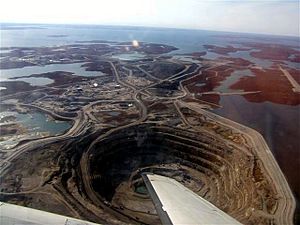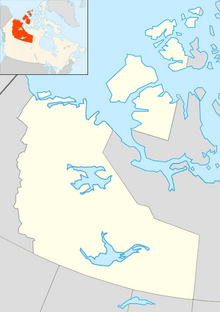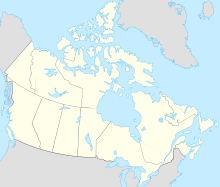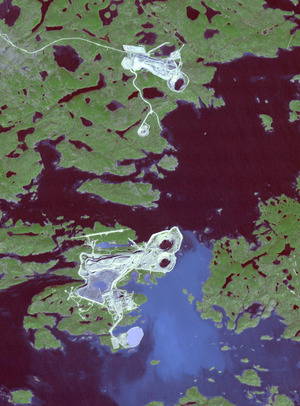Diavik Diamond Mine facts for kids

Diavik mine in 2006
|
|
| Location | |
|---|---|
| Location | Lac de Gras |
| Territory | Northwest Territories |
| Country | Canada |
| Coordinates | 64°29′46″N 110°16′24″W / 64.49611°N 110.27333°W |
| Production | |
| Products | Diamonds |
| History | |
| Opened | 2003 |
| Owner | |
| Company | Rio Tinto and Dominion Diamond Corporation, operated by Rio Tinto company Diavik Diamond Mines Inc. |
The Diavik Diamond Mine is a very important diamond mine in Canada. It is located in the North Slave Region of the Northwest Territories. This mine is about 300 kilometers (186 miles) northeast of Yellowknife.
Contents
What is the Diavik Mine?
The Diavik Diamond Mine is a large industrial site. It is built in a very cold, remote area called the subarctic. The mine gets its diamonds from four special rock formations. These are called kimberlite pipes. They are found under a lake called Lac de Gras. The mine itself is on an island in this lake, which is about 20 square kilometers (7.7 square miles) big. This island is sometimes called East Island. The mine is also about 220 kilometers (137 miles) south of the Arctic Circle.
If you look at satellite images, you can see the mine's main parts. There are two large open pits where mining happens. There's also a big pile of waste rock. The mine has an airstrip that can handle large planes. These include Boeing 737s and C-130s. The site also has many buildings. These include places for processing diamonds and making power. There are also fuel tanks, water treatment plants, and homes for the workers.
The mine is connected to other places by an ice road. This road is used in winter. It also has the Diavik Airport. This airport has a gravel runway that is 5,234 feet long.
Who Owns and Operates the Mine?
The Diavik mine is owned by two companies working together. These are the Rio Tinto Group (60%) and Dominion Diamond Corporation (40%). The mine is run by Diavik Diamond Mines Inc. This company is a part of the Rio Tinto Group.
The mine started producing diamonds in 2003. It is expected to operate for about 16 to 22 years. The Diavik mine is very important for the local economy. It employs about 1,000 people. Each year, it produces around 7 million carats of diamonds. That's about 1,400 kilograms (3,086 pounds) of diamonds!
History of the Diavik Mine
The area where the mine is located was first explored in 1992. Construction of the mine began in 2001. Diamond production officially started in January 2003.
In 2006, the special ice road to the mine froze late. It also thawed earlier than usual. This meant the Diavik mine could not bring in all its supplies by truck. So, they had to fly in the rest of the supplies. Since then, the annual ice road resupply has gone as planned.
In March 2010, the mine started digging for diamonds underground. Before this, they used open pits. The change from open pit to underground mining was finished in September 2012.
Green Energy at the Mine
In September 2012, Diavik built a large wind farm. This was the first of its kind in the Northwest Territories. It has four wind turbines. These turbines can produce 9.2 megawatts of power.
This wind farm provides about 11% of the mine's yearly power needs. It works very well, about 98% of the time. Using wind power helps the mine save a lot of diesel fuel. It saves about 5 million liters (1.3 million gallons) of fuel each year. The Diavik mine has the world's largest wind-diesel power system. This system works even in very cold temperatures, down to -40 degrees Celsius (-40 degrees Fahrenheit).
New Developments and Big Discoveries
In 2015, the mine announced a big investment. They planned to spend $350 million US dollars. This money was for developing a fourth kimberlite pipe. This new area is called A21. Like the other diamond areas, A21 is under the shallow waters of Lac de Gras. To get to it, they built a rockfill dike. This dike was finished in 2018. The first diamonds from A21 were expected in the fall of that year.
In December 2015, something exciting happened. Rio Tinto announced the discovery of the 187.7-carat Diavik Foxfire diamond. This was one of the largest high-quality diamonds ever found in Canada. The Diavik Foxfire was given a special name. In the Tlicho First Nation language, it is called Noi?eh Kwe. This means "caribou crossing stone."
Even bigger news came in October 2018. A huge yellow diamond was found at the mine. It weighed 552 carats! This is the largest diamond ever discovered in North America.
Images for kids
See also
 In Spanish: Mina de diamantes Diavik para niños
In Spanish: Mina de diamantes Diavik para niños





